Get the glutes you've always wanted with deep squats.
Author:
Julio Valero
Published on:
2/20/2025

Effects of squat training with different depths on lower limb muscle volume.
If your goal is to develop your glute and inner thigh muscles, a greater range of motion is key.
Overview
Research on the influence of squat range of motion (full vs. partial) on muscle growth during a 10-week training program.
A full range of motion resulted in greater muscle growth in the glutes and adductors compared to a half squat. The quadriceps grew similarly in both groups, with no changes in the hamstrings.
To maximize the development of the lower body muscles, especially the glutes and adductors, it is critical to perform the exercises with a full range of motion.
What's the problem?
The barbell squat is a fundamental exercise in strength training, appreciated for its ability to develop both muscle mass and overall strength. This compound exercise involves multiple lower body joints, such as the ankles, knees, hips and spine, making it a complex and complete movement. The barbell squat allows for lifting considerable loads due to the fact that it recruits the largest and most powerful muscle groups in the body. Its multi-joint nature and its transfer of benefits to various sporting activities make the squat a versatile exercise, suitable for different objectives, from sports performance and aesthetic improvement to rehabilitation and injury prevention.
The barbell squat requires active engagement of most of the muscles in the lower body, including the quadriceps hamstrings, hamstrings, glutes, hip adductors, and calves. In addition, numerous muscles are activated to stabilize and support the core during the exercise. The quadriceps, located on the front of the thighs, are responsible for knee extension, while the hamstrings, located on the back of the thighs, contribute to hip extension. The gluteus maximus, the primary hip extensor muscle, plays a crucial role in the force generated during the squat.
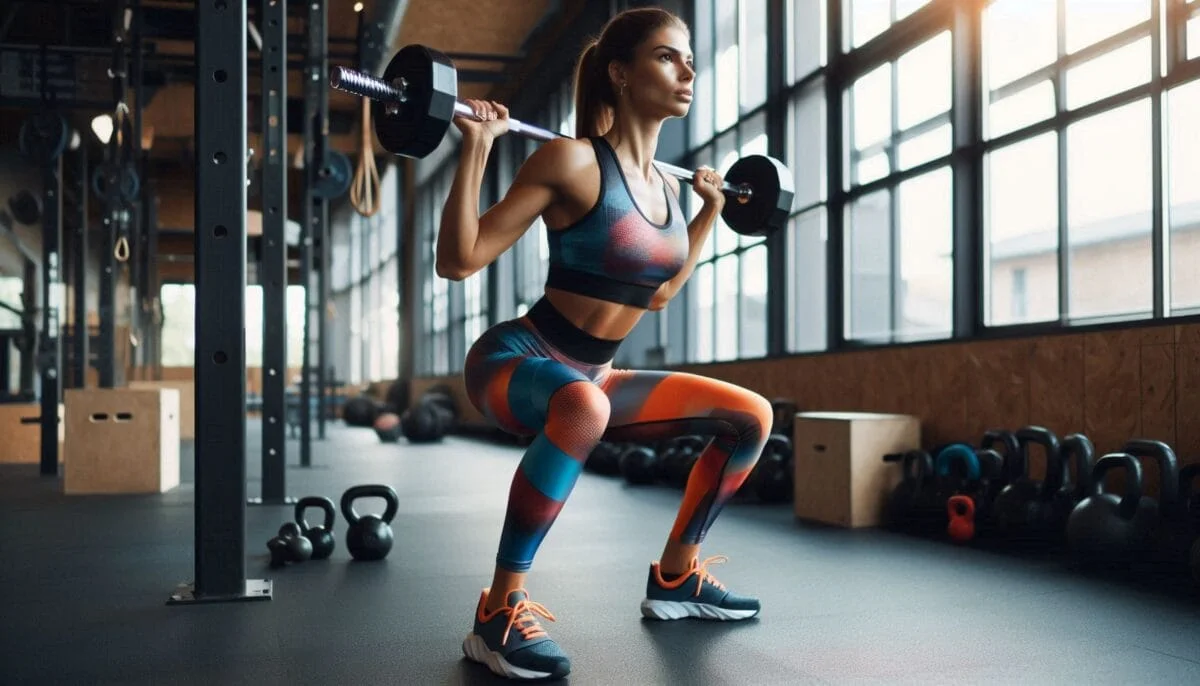
The squat is a versatile exercise with many variations. Depth or range of motion (ROM) is a key factor. There are three main types of squats based on ROM, as measured by knee flexion angle:
Parcial : ángulo de rodilla de 40°
Paralelo (mitad): ángulo de rodilla de 70 a 100°
Profundo: ángulo de rodilla superior a 100°
Squat depth is a topic of debate among trainers and fitness professionals. While some advocate shallower squats, scientific evidence suggests that deep squats are more effective at increasing muscle strength and size. In this article, we will discuss a key study and other recent research that supports this claim.
Purpose
Researchers measured changes in leg muscle volume and strength after a squat training program, comparing a full range of motion to a partial range of motion.
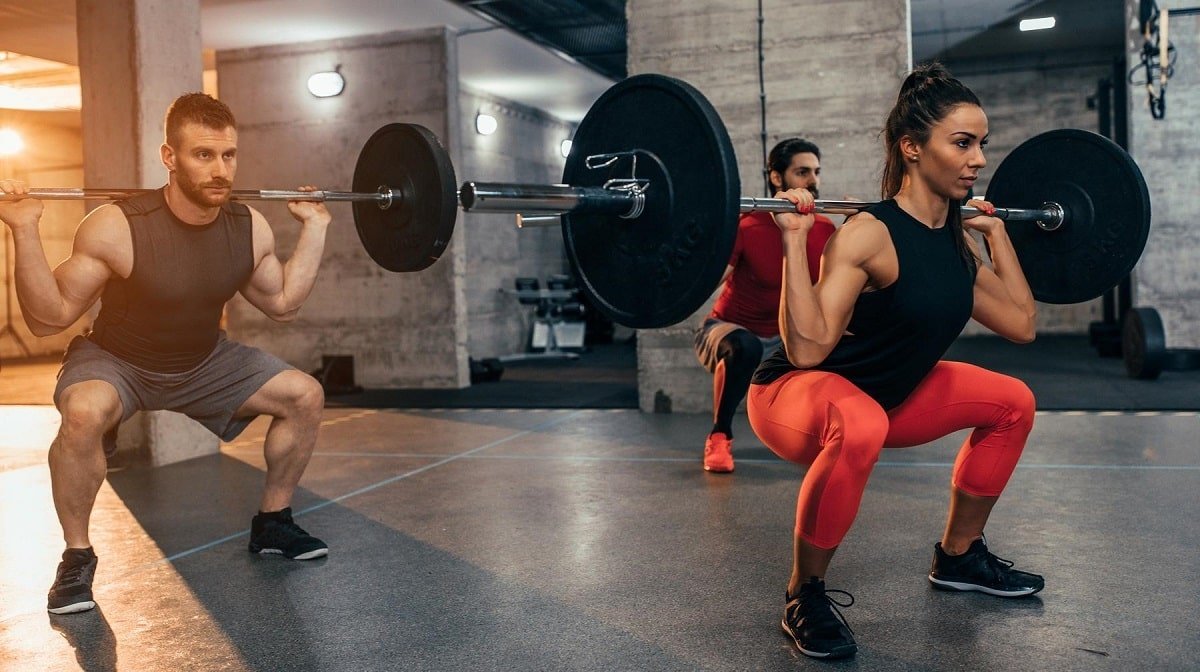
Hypothesis
An increase in the volume of the knee extensors, gluteus maximus, and adductor muscles was anticipated with full range training, but not in the hamstrings.
What Did They Test and How?
Participants
This study was conducted with 20 healthy men who had not participated in any structured physical training program for at least one year prior to the study. Three of them (two in the full study and one in the partial study) were unable to continue due to injury or illness (two cases) and lack of interest (one case). Therefore, the final data analysis was performed with 17 participants (eight in the full study and nine in the partial study). Table 1 shows the characteristics of the participants.
Table 1 Participant Characteristics
Full squat training (n = 8 | )Half squat training (n = 9) | |
Age (years) | 20.7 (0.4) | 20.9 (0.8) |
Height (cm) | 173.6 (4.1) | 172.3 (5.8) |
Body mass (kg) | 63.2 (6.6) | 64.1 (6.1) |
1RM of full squat (kg) | 78.8 (14.6) | 82.8 (15.2) |
1RM of half squat (kg) | 95.0 (16.0) | 96.7 (15.0) |
Data are presented as group means (SD), 1RM: one repetition maximum.
Study procedures
Participants were divided into two groups: one for full squat training and one for half squat training. After two familiarization sessions with detailed instructions, participants in each group performed the assigned exercise. Full squats involved a full range of motion, from full knee extension to 140 degrees of flexion, and vice versa. Half squats, on the other hand, were characterized by a shorter range of motion, from full knee extension to 90 degrees of flexion.
Two groups participated in a ten-week training program, exercising twice per week. Each group used a different range of motion (full or half) and sessions were supervised to ensure adequate depth. The percentage of 1RM was increased weekly and, if participants completed the target sets and reps with correct form, the training load was increased by 5 kg (~11 lbs) for the next session. Total training volume was calculated by multiplying the load, reps, and barbell movement distance, which was measured using video analysis and specialized software.
Measures
Using magnetic resonance imaging (MRI), the most accurate method for assessing muscle volume, the size of the main leg muscles was measured: the quadriceps femoris, adductors, gluteus maximus and hamstrings, which are the largest muscle groups in this area.
The maximum strength of the participants was assessed using the 1RM (one repetition maximum) test. This test consists of determining the maximum weight that a person can lift in a single repetition. In this study, the 1RM of the barbell squat was measured in two variations: full squat (full range) and partial squat (mid range).

Quadriceps Femoris (Knee Extensors)
Rectus Femoris (RF)
Vastus Lateralis (VL)
Vastus Intermedius (VI)
Vastus Medius (VM)
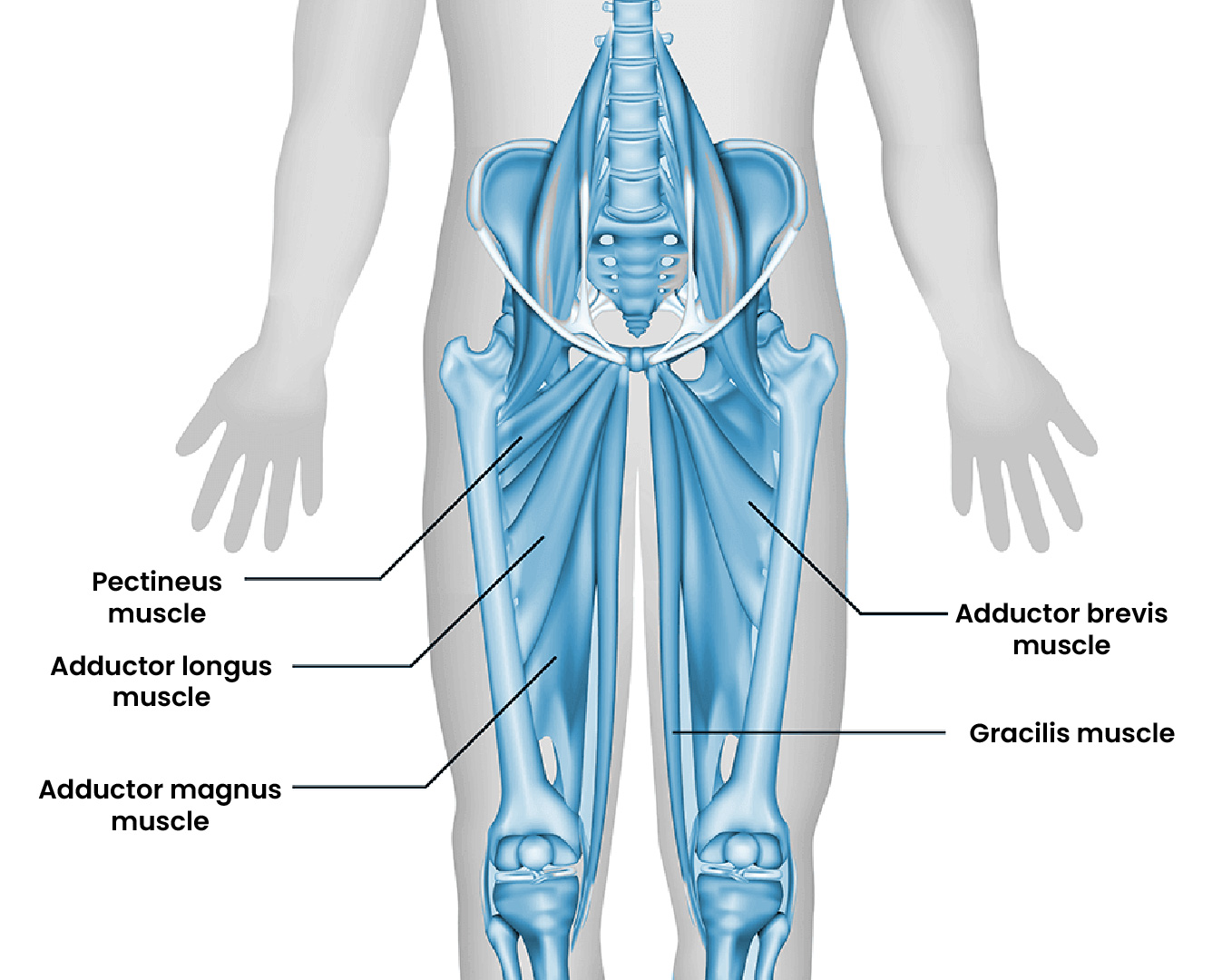
Adductors
Adductor Magnus
Adductor Longus
Adductor Brevis
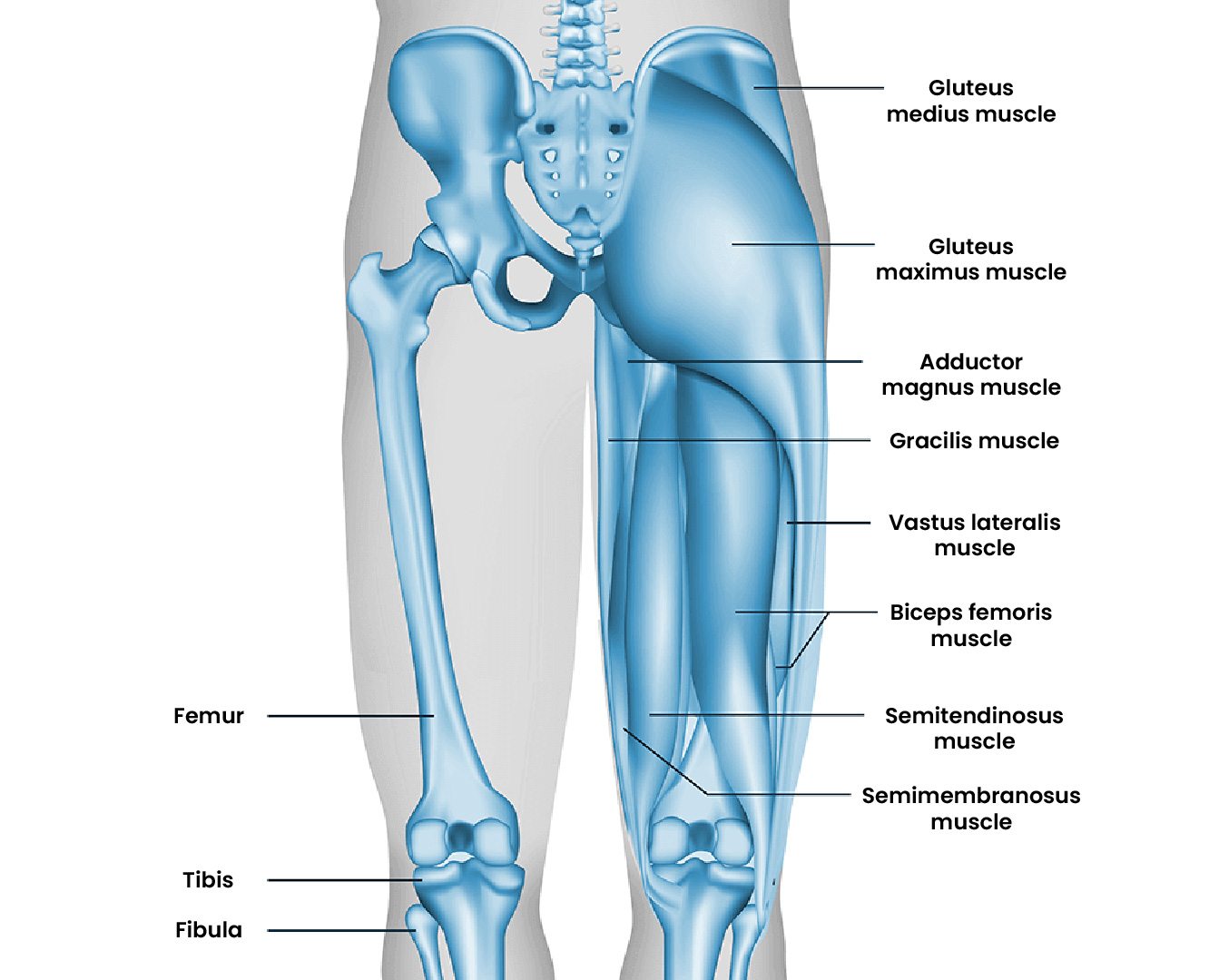
Gluteus Maximus (Hamstrings)
Biceps Femoris Short Head (BFs)
Biceps Femoris Long Head (BFl)
Semitendinosus (ST)
Semimembranosus (SM)
What Did They Find?
Muscle Growth
Both full-range and mid-range squats resulted in similar growth of the quadriceps and hamstring muscles. However, full-range squats showed a slightly greater increase in the adductor (3.8%) and gluteus maximus (4.5%) muscles. Figure 2 illustrates the changes in muscle volume. Interestingly, the rectus femoris (a quadriceps muscle) experienced no change in either group, and the hamstrings also showed no change. Table 2 shows the changes in size of the quadriceps muscles that did increase in size.
Figure 2 Percentage change in muscle volume of lower body muscles after ten weeks of full squat or half squat training.
Blue diamonds highlight a significant change between the initial and final test, while purple rectangles indicate a notable difference between groups.
Table 2 Average change in quadricep (knee extensor) size before and after ten weeks of training
Quadricep (knee extensor) muscle | Full squat group (n = 8) | Half squat group (n = 9) |
Vastus lateralis muscle (cm2) | 43.7 | 40.2 |
Vastus intermedius muscle (cm2) | 19.7 | 24.0 |
Vastus medialis muscle (cm2) | 32.3 | 30.6 |
Group average changes after 10 weeks of squat training are presented, comparing full and half squat modalities.
Figure 3 MRI images showing mid-thigh cross sections before and after training.
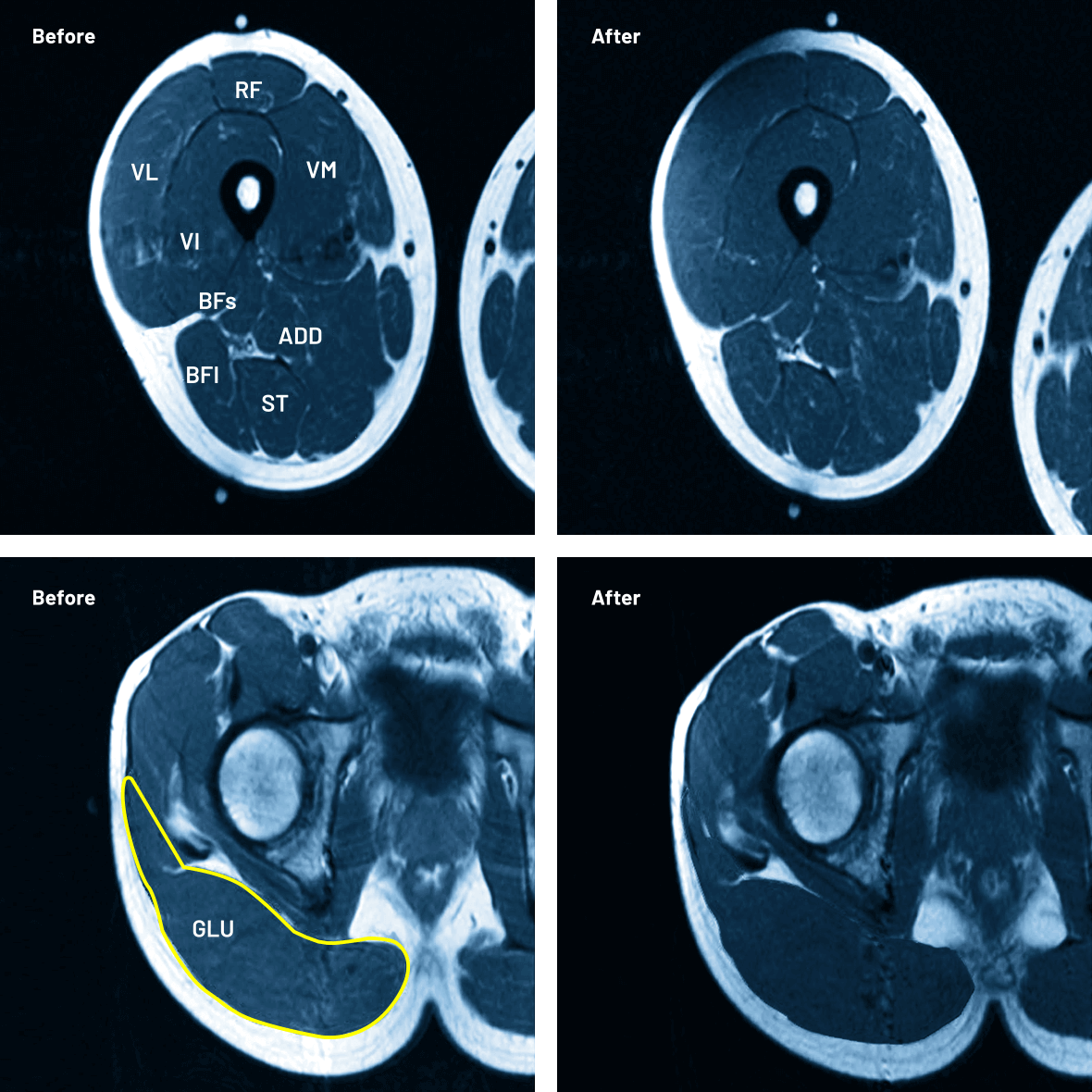
Rectus femoris (RF), vastus lateralis (VL), vastus intermedius (VI), vastus medialis (VM), biceps femoris short head (BFs), biceps femoris long head (BFl), semitendinosus (ST), semimembranosus (SM), adductor muscles (ADD), gluteus maximus (GLU).
Strength
Our study found that squats performed with a full range of motion (from the starting position to the end position) were more effective at increasing maximal strength by 20% compared to squats performed with a partial range of motion (only half the range of motion). Although training with a half range of motion also produced significant improvements in strength, these results did not reach the same level of improvement as training with a full range of motion.
Importantly, while not statistically significant (p = 0.132), we observed that the group that trained with a half range of motion showed a tendency to obtain better results in the mid-range squat test. This suggests that this type of training could have specific benefits for strengthening the middle part of the movement.
What Do the Findings Mean?
A recent study (supported by research from 2019) shows that training with a wider range of motion (like deep squats) leads to greater muscle growth in the glutes and adductors. Although the study is small, it uses MRI to measure muscle growth, which provides very accurate results. The results of this study contradict some common beliefs about training, but scientific evidence is more important than personal opinions. This study focuses on the glutes and adductors, but other similar research on quads found that both full and partial range of motion are effective. More studies like this are needed to confirm these findings and explore other muscle groups.
A study investigates the biomechanical factors that influence gluteal and adductor performance during exercise. The authors propose that deep squats result in greater hip adductor activation and an increase in hip extension torque in the bottom phase of the movement. This hypothesis is based on previous findings supporting the relationship between squat depth and muscle activation.
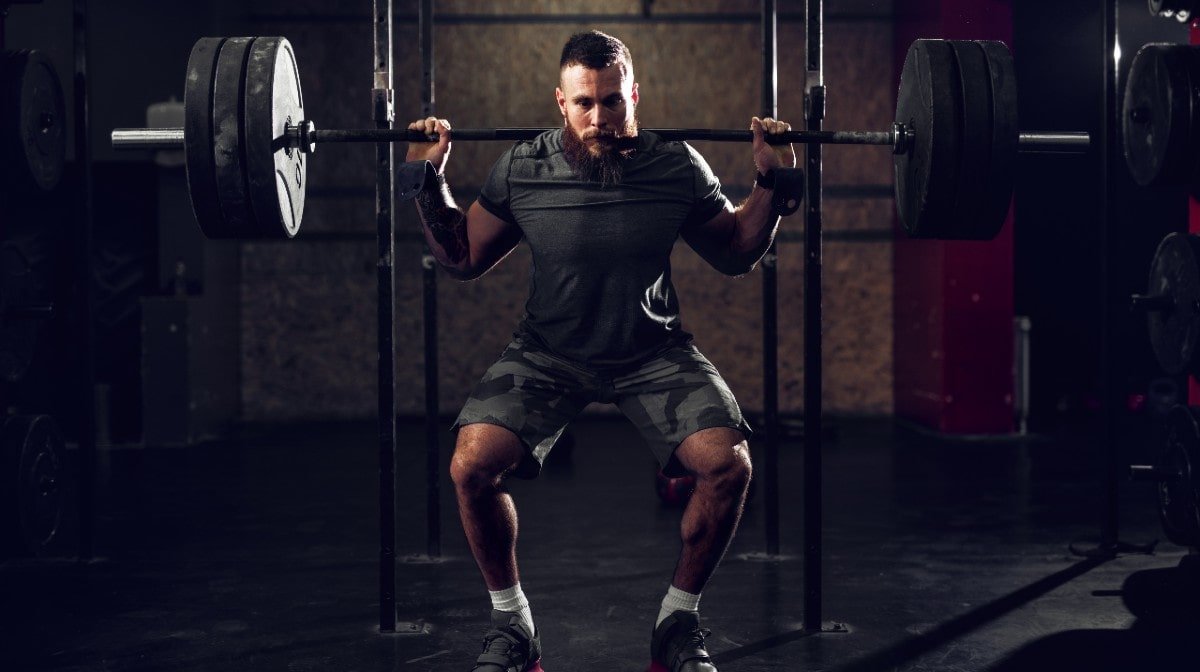
These changes in muscle activation could explain why the glutes and adductors respond differently to exercise. Another theory suggests that deeper squats require greater effort from the hip and back extensor muscles, which would also explain the observed results.
Finally, the possibility that the strength-length or length-tension relationship plays an important role is raised. It has been suggested that a partial range of motion (ROM) in some exercises could prevent reaching the "zone" of maximum active tension, which would decrease the effectiveness of the exercise for muscle growth.
Recent studies suggest that leg extensions are more effective than squats for increasing rectus femoris size. This is because the rectus femoris is a bi-articular muscle that flexes the hip and extends the knee. In squats, hip extension counteracts flexion, limiting the work of the rectus femoris. Therefore, leg extensions, by not including hip extension, are better suited for this muscle.
The idea of sacrificing range of motion for heavier lifting is common in strength training. It is argued that a greater load could lead to greater gains in strength or muscle size. However, research suggests otherwise. A recent study found that a full range of motion, even if it uses lighter loads, is more effective than a partial range of motion for muscle development.
In terms of strength outcomes, this study reveals that improvements in 1RM testing are maximized in the specific range of motion used during training. That is, full range of motion training results in improved performance in full range 1RM tests, while partial range of motion training improves performance in partial range 1RM tests. This finding supports previous research showing that training, whether full or partial range, optimizes strength gains for that specific condition.
Current research suggests that full range of motion is the most effective way to increase muscle size and strength. These results underscore the importance of considering each person's individual characteristics and biomechanics when designing training programs.

How Can You Apply These Findings?
The ideal range of motion for squats depends on your training goals. If you're looking to maximally develop your glute and inner thigh muscles, a full range of motion is most recommended. This means lowering yourself until your hips are below your knees, which is known as "breaking parallel."
If your primary goal is to gain strength in the squat, especially if you're a powerlifter, then you'll also benefit from performing the exercise with a full range of motion. However, it's important to remember that powerlifters only need to lower themselves as far as their sport requires. In most federations, this means that the tops of the thighs (hip crease) should be below the tops of the knees.
While some bodybuilders may choose to go even lower ("ass to floor"), for powerlifters this may be unnecessary and even counterproductive, as it provides no additional benefits for their sport and may increase the risk of injury.
On the other hand, if your main goal is to develop the quads and you are not as concerned about the glutes or adductors, you can perform squats with a partial range of motion, i.e. without needing to go all the way to parallel.
In any case, it is essential to perform squats correctly and in a controlled manner. Avoid lifting too much weight if you do not have the proper technique, as this can increase the risk of injury.
The rectus femoris showed no growth with squat protocols. For optimal quad development, incorporate isolation exercises such as leg extensions or sissy squats, which isolate the hip and effectively work the rectus femoris.
Prioritize safety when exercising. Consult a health professional to assess your capabilities and prevent injury. If you cannot do a full squat, a half squat is a good start. It is not necessary to include the barbell squat; there are many effective alternatives such as front squats, step-ups, lunges, and other options with machines or bodyweight.
References
Kubo, K., Ikebukuro, T., & Yata, H. (2019). Effects of squat training with different depths on lower limb muscle volumes. European journal of applied physiology, 119(9), 1933–1942.
Escamilla, R. F., Fleisig, G. S., Zheng, N., Lander, J. E., Barrentine, S. W., Andrews, J. R., Bergemann, B. W., & Moorman, C. T., 3rd (2001). Effects of technique variations on knee biomechanics during the squat and leg press. Medicine and science in sports and exercise, 33(9), 1552–1566.
Schoenfeld B. J. (2010). Squatting kinematics and kinetics and their application to exercise performance. Journal of strength and conditioning research, 24(12), 3497–3506.
Bryanton, M. A., Carey, J. P., Kennedy, M. D., & Chiu, L. Z. (2015). Quadriceps effort during squat exercise depends on hip extensor muscle strategy. Sports biomechanics, 14(1), 122–138.
McMahon, G. E., Morse, C. I., Burden, A., Winwood, K., & Onambélé, G. L. (2014). Impact of range of motion during ecologically valid resistance training protocols on muscle size, subcutaneous fat, and strength. Journal of strength and conditioning research, 28(1), 245–255.
Bloomquist, K., Langberg, H., Karlsen, S., Madsgaard, S., Boesen, M., & Raastad, T. (2013). Effect of range of motion in heavy load squatting on muscle and tendon adaptations. European journal of applied physiology, 113(8), 2133–2142.
Pallarés, J. G., Hernández-Belmonte, A., Martínez-Cava, A., Vetrovsky, T., Steffl, M., & Courel-Ibáñez, J. (2021). Effects of range of motion on resistance training adaptations: A systematic review and meta-analysis. Scandinavian journal of medicine & science in sports, 31(10), 1866–1881.
Schoenfeld, B. J., & Grgic, J. (2020). Effects of range of motion on muscle development during resistance training interventions: A systematic review. SAGE open medicine, 8, 2050312120901559.
Kojic, F., Ðurić, S., Ranisavljev, I., Stojiljkovic, S., & Ilic, V. (2021). Quadriceps femoris cross-sectional area and specific leg strength: relationship between different muscles and squat variations. PeerJ, 9, e12435.
Valamatos, M. J., Tavares, F., Santos, R. M., Veloso, A. P., & Mil-Homens, P. (2018). Influence of full range of motion vs. equalized partial range of motion training on muscle architecture and mechanical properties. European journal of applied physiology, 118(9), 1969–1983.
Zabaleta-Korta, A., Fernández-Peña, E., Torres-Unda, J., Garbisu-Hualde, A., & Santos-Concejero, J. (2021). The role of exercise selection in regional Muscle Hypertrophy: A randomized controlled trial. Journal of sports sciences, 39(20), 2298–2304.
Nagura, T., Dyrby, CO, Alexander, EJ, y Andriacchi, TP (2002). Cargas mecánicas en la articulación de la rodilla durante la flexión profunda . Revista de investigación ortopédica: publicación oficial de la Sociedad de Investigación Ortopédica, 20(4), 881–886.
Pallarés, JG, Cava, AM, Courel-Ibáñez, J., González-Badillo, JJ, y Morán-Navarro, R. (2020). La sentadilla completa produce mayores adaptaciones neuromusculares y funcionales y menor dolor que las sentadillas parciales tras un entrenamiento de resistencia prolongado. Revista europea de ciencias del deporte, 20(1), 115–124.
Martínez-Cava, A., Hernández-Belmonte, A., Courel-Ibáñez, J., Morán-Navarro, R., González-Badillo, JJ, & Pallarés, JG (2022). El press de banca en rango completo de movimiento produce mayores adaptaciones neuromusculares que las ejecuciones parciales después de un entrenamiento de resistencia prolongado. Revista de investigación de fuerza y acondicionamiento, 36(1), 10–15.
Robertson, DGE, Wilson, JMJ y Pierre, TAS (2008). Funciones musculares de las extremidades inferiores durante sentadillas completas. Journal of applied biomechanics, 24(4), 333-339.
Comparte en redes sociales
Recent posts

A bad night's sleep: a reason to stay up even longer?

Creatine Effectiveness: What Does Science Say About Its Benefits?

Does meal timing help you lose fat?
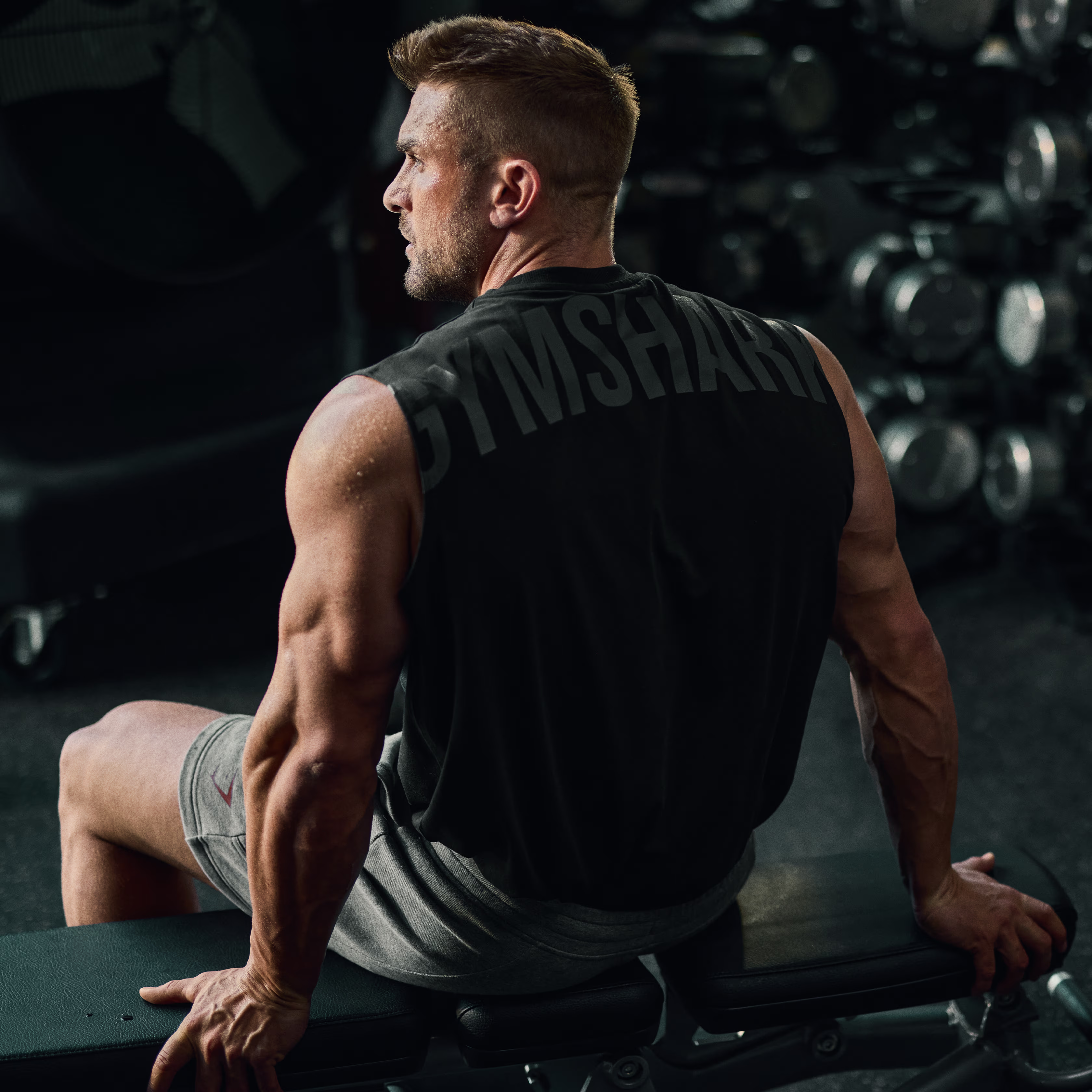
Is your triceps press building muscle or holding you back?

Nutrition tailored to you: based on your genetic profile.

Carbohydrates: the key to an explosive workout.